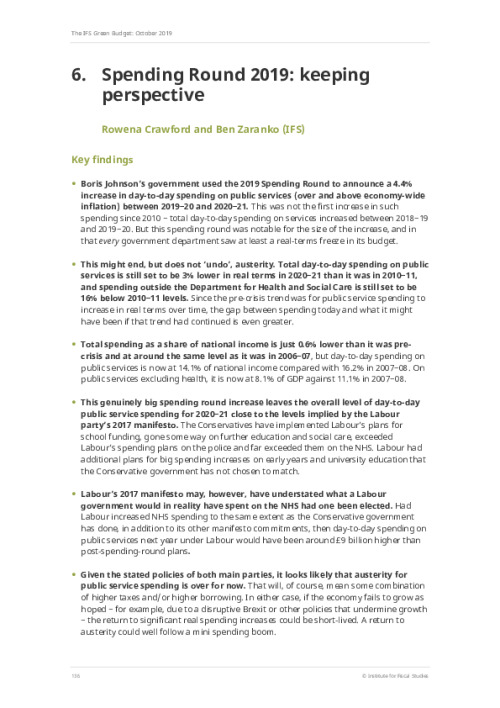The 2019 Spending Round, published in September 2019, set departmental budgets for the 2020−21 financial year. Chancellor Sajid Javid topped up the spending plans pencilled in by his predecessor, announced spending increases across the board and declared austerity to be over. But these increases must be seen in context: austerity may have ‘ended’ but it is far from undone. And a decade of spending restraint means that even after recent announcements, spending on public services next year will be well below where we might have expected it to be, given historical rates of spending growth and growth in national income.
In this chapter, we describe the announcements in this year’s spending pound and emphasise the importance of keeping perspective. We consider the announced spending increases in the context of the real-terms cuts since 2010, and the longer-run history of public spending, and also compare it with the plans implied by the Labour party’s 2017 election manifesto.
Day-to-day spending on public services over the past decade

Key findings
- Boris Johnson’s government used the 2019 Spending Round to announce a 4.4% increase in day-to-day spending on public services (over and above economy-wide inflation) between 2019−20 and 2020− This was not the first increase in such spending since 2010 – total day-to-day spending on services increased between 2018−19 and 2019−20. But this spending round was notable for the size of the increase, and in that every government department saw at least a real-terms freeze in its budget.
- This might end, but does not ‘undo’, austerity. Total day-to-day spending on public services is still set to be 3% lower in real terms in 2020−21 than it was in 2010−11, and spending outside the Department for Health and Social Care is still set to be 16% below 2010−11 levels. Since the pre-crisis trend was for public service spending to increase in real terms over time, the gap between spending today and what it might have been if that trend had continued is even greater.
- Total spending as a share of national income is just 0.6% lower than it was pre-crisis and at around the same level as it was in 2006−07, but day-to-day spending on public services is now at 14.1% of national income compared with 16.2% in 2007− On public services excluding health, it is now at 8.1% of GDP against 11.1% in 2007−08.
- This genuinely big spending round increase leaves the overall level of day-to-day public service spending for 2020−21 close to the levels implied by the Labour party’s 2017 manifesto. The Conservatives have implemented Labour’s plans for school funding, gone some way on further education and social care, exceeded Labour’s spending plans on the police and far exceeded them on the NHS. Labour had additional plans for big spending increases on early years and university education that the Conservative government has not chosen to match.
- Labour’s 2017 manifesto may, however, have understated what a Labour government would in reality have spent on the NHS had one been elected. Had Labour increased NHS spending to the same extent as the Conservative government has done, in addition to its other manifesto commitments, then day-to-day spending on public services next year under Labour would have been around £9 billion higher than post-spending-round plans.
- Given the stated policies of both main parties, it looks likely that austerity for public service spending is over for now. That will, of course, mean some combination of higher taxes and/or higher borrowing. In either case, if the economy fails to grow as hoped – for example, due to a disruptive Brexit or other policies that undermine growth – the return to significant real spending increases could be short-lived. A return to austerity could well follow a mini spending boom.










